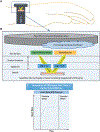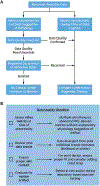Consumer Wearable Health and Fitness Technology in Cardiovascular Medicine: JACC State-of-the-Art Review
- PMID: 37438010
- PMCID: PMC10662962
- DOI: 10.1016/j.jacc.2023.04.054
Consumer Wearable Health and Fitness Technology in Cardiovascular Medicine: JACC State-of-the-Art Review
Abstract
The use of consumer wearable devices (CWDs) to track health and fitness has rapidly expanded over recent years because of advances in technology. The general population now has the capability to continuously track vital signs, exercise output, and advanced health metrics. Although understanding of basic health metrics may be intuitive (eg, peak heart rate), more complex metrics are derived from proprietary algorithms, differ among device manufacturers, and may not historically be common in clinical practice (eg, peak V˙O2, exercise recovery scores). With the massive expansion of data collected at an individual patient level, careful interpretation is imperative. In this review, we critically analyze common health metrics provided by CWDs, describe common pitfalls in CWD interpretation, provide recommendations for the interpretation of abnormal results, present the utility of CWDs in exercise prescription, examine health disparities and inequities in CWD use and development, and present future directions for research and development.
Keywords: athlete; exercise; fitness; photoplethysmography; wearable device.
Copyright © 2023 American College of Cardiology Foundation. Published by Elsevier Inc. All rights reserved.
Conflict of interest statement
Funding Support and Author Disclosures The authors have reported that they have no relationships relevant to the contents of this paper to disclose.
Figures







Similar articles
-
Wearable activity trackers-advanced technology or advanced marketing?Eur J Appl Physiol. 2022 Sep;122(9):1975-1990. doi: 10.1007/s00421-022-04951-1. Epub 2022 Apr 21. Eur J Appl Physiol. 2022. PMID: 35445837 Free PMC article. Review.
-
Using Fitness Trackers and Smartwatches to Measure Physical Activity in Research: Analysis of Consumer Wrist-Worn Wearables.J Med Internet Res. 2018 Mar 22;20(3):e110. doi: 10.2196/jmir.9157. J Med Internet Res. 2018. PMID: 29567635 Free PMC article.
-
Accuracy of Optical Heart Rate Sensing Technology in Wearable Fitness Trackers for Young and Older Adults: Validation and Comparison Study.JMIR Mhealth Uhealth. 2020 Apr 28;8(4):e14707. doi: 10.2196/14707. JMIR Mhealth Uhealth. 2020. PMID: 32343255 Free PMC article.
-
Characterizing Real-World Implementation of Consumer Wearables for the Detection of Undiagnosed Atrial Fibrillation in Clinical Practice: Targeted Literature Review.JMIR Cardio. 2023 Nov 3;7:e47292. doi: 10.2196/47292. JMIR Cardio. 2023. PMID: 37921865 Free PMC article. Review.
-
Recommendations for determining the validity of consumer wearable heart rate devices: expert statement and checklist of the INTERLIVE Network.Br J Sports Med. 2021 Jul;55(14):767-779. doi: 10.1136/bjsports-2020-103148. Epub 2021 Jan 4. Br J Sports Med. 2021. PMID: 33397674 Free PMC article.
Cited by
-
Wearable Devices for Exercise Prescription and Physical Activity Monitoring in Patients with Various Cardiovascular Conditions.CJC Open. 2025 Mar 3;7(5):695-706. doi: 10.1016/j.cjco.2025.02.017. eCollection 2025 May. CJC Open. 2025. PMID: 40433214 Free PMC article. Review.
-
Wearable Technology in Cardiology: Advancements, Applications, and Future Prospects.Rev Cardiovasc Med. 2025 Jun 27;26(6):39025. doi: 10.31083/RCM39025. eCollection 2025 Jun. Rev Cardiovasc Med. 2025. PMID: 40630441 Free PMC article. Review.
-
Emerging trends in management of long COVID with a focus on pulmonary rehabilitation: A review.Clin Respir J. 2024 May;18(5):e13777. doi: 10.1111/crj.13777. Clin Respir J. 2024. PMID: 38775379 Free PMC article. Review.
-
2025 Japanese Heart Rhythm Society / Japanese Circulation Society Consensus Statement on the Appropriate Use of Ambulatory and Wearable Electrocardiographs.J Arrhythm. 2025 May 23;41(3):e70059. doi: 10.1002/joa3.70059. eCollection 2025 Jun. J Arrhythm. 2025. PMID: 40416951 Free PMC article.
-
Heart Rate Variability and Pulse Rate Variability: Do Anatomical Location and Sampling Rate Matter?Sensors (Basel). 2024 Mar 23;24(7):2048. doi: 10.3390/s24072048. Sensors (Basel). 2024. PMID: 38610260 Free PMC article.
References
-
- Dagher L, Shi H, Zhao Y, Marrouche NF. Wearables in cardiology: here to stay. Heart Rhythm. 2020;17:889–895. - PubMed
-
- Seneviratne MG, Connolly SB, Martin SS, Parakh K. Grains of sand to clinical pearls: realizing the potential of wearable data. Am J Med. 2023;136:136–142. - PubMed
-
- Corday E. Historical vignette celebrating the 30th anniversary of diagnostic ambulatory electrocardiographic monitoring and data reduction systems. J Am Coll Cardiol. 1991;17:286–292. - PubMed
Publication types
MeSH terms
Substances
Grants and funding
LinkOut - more resources
Full Text Sources

